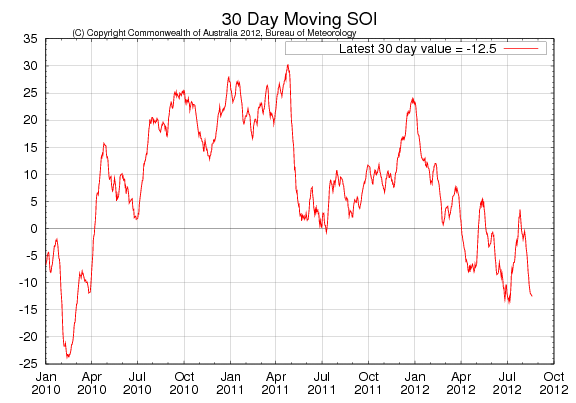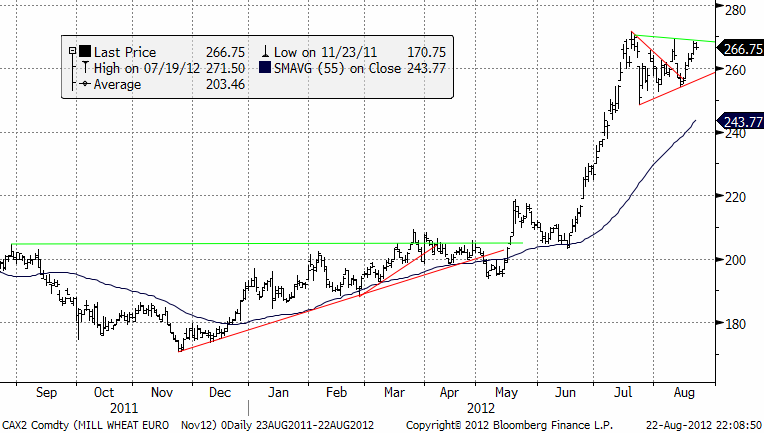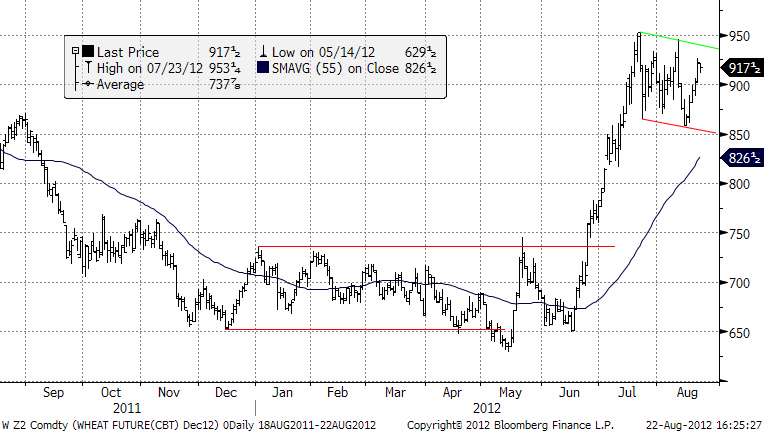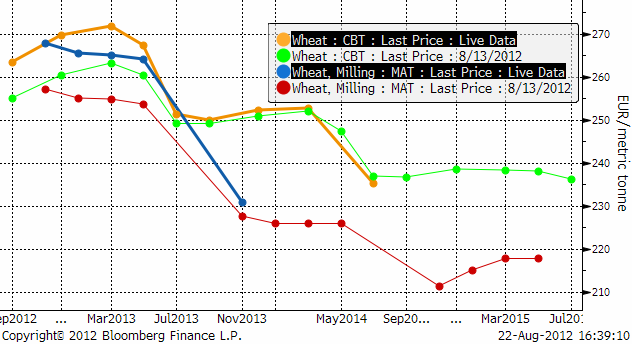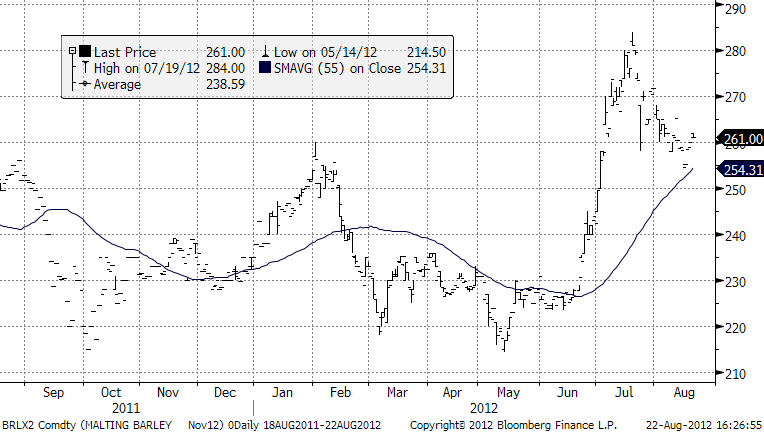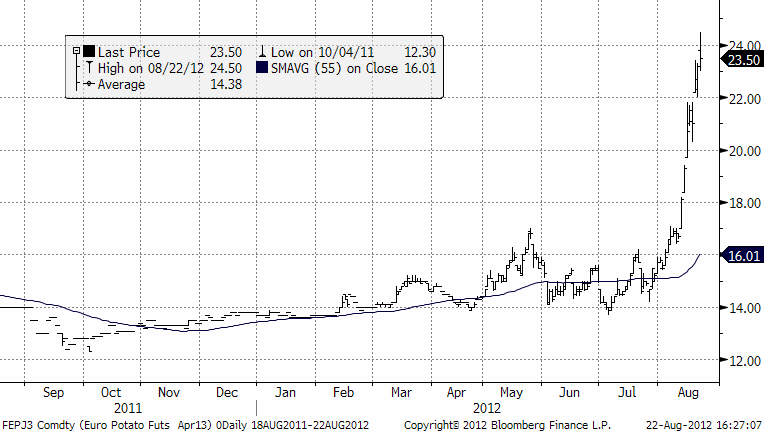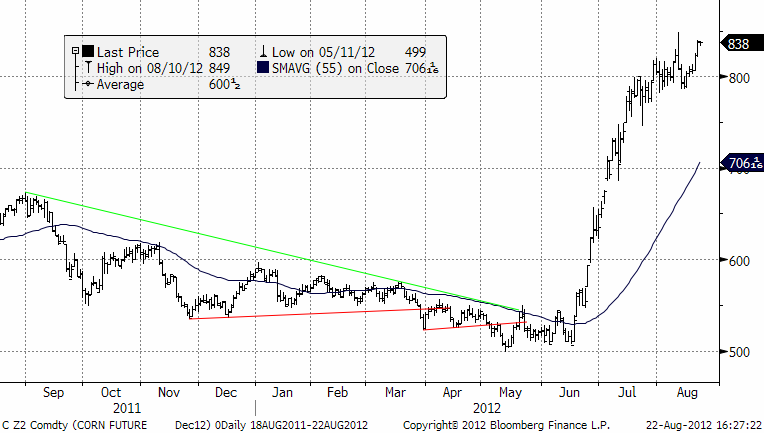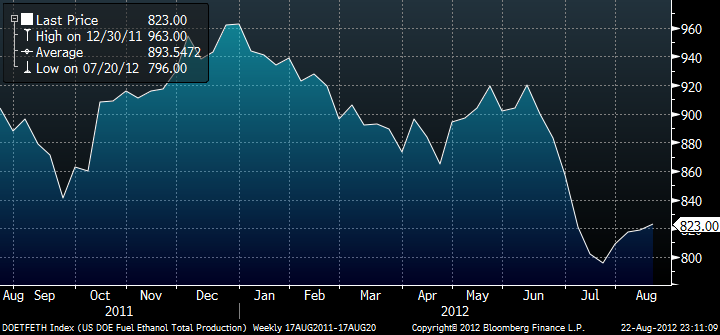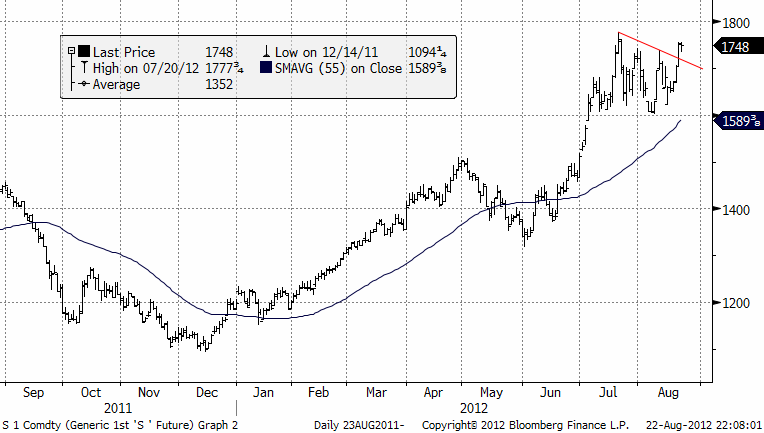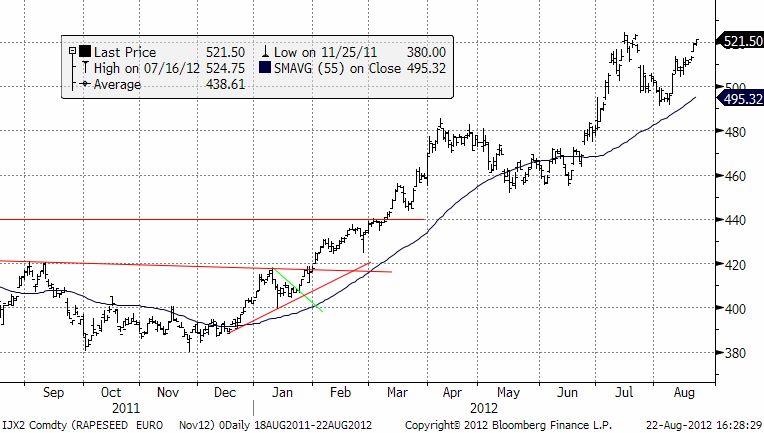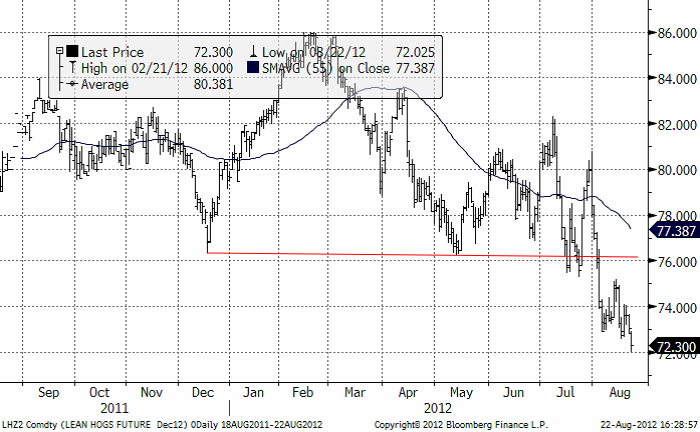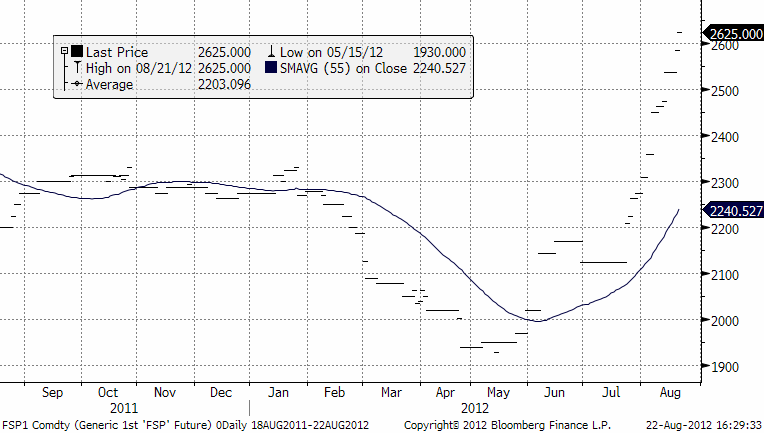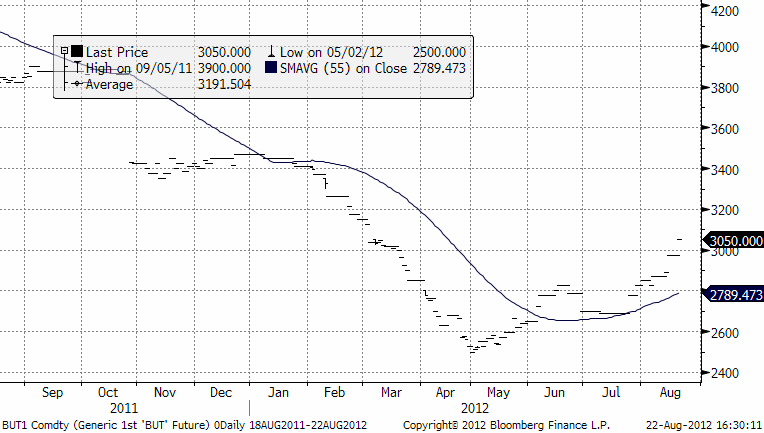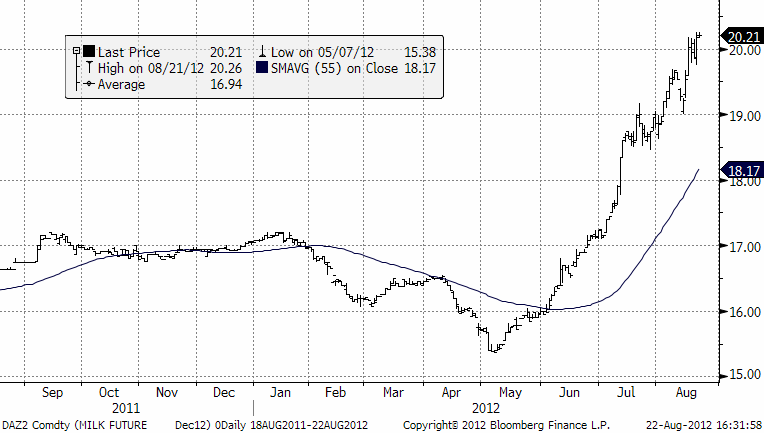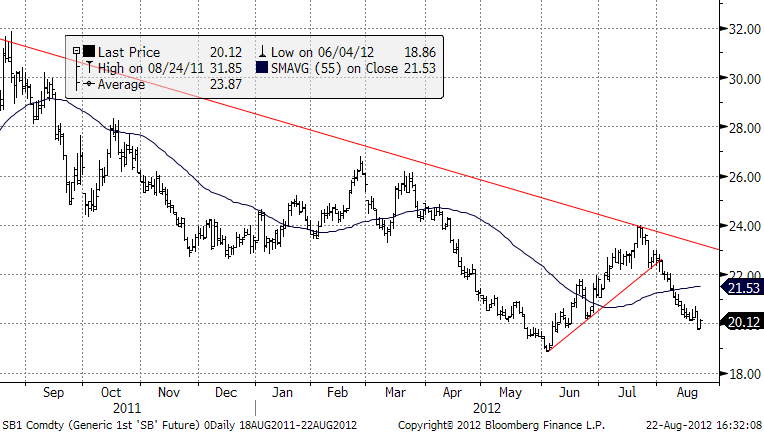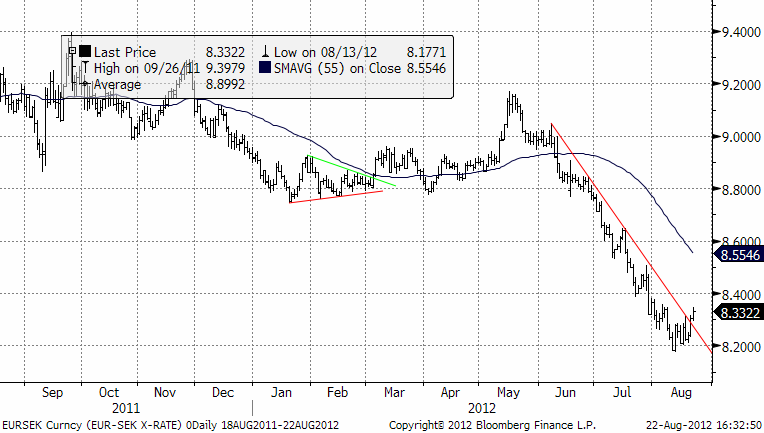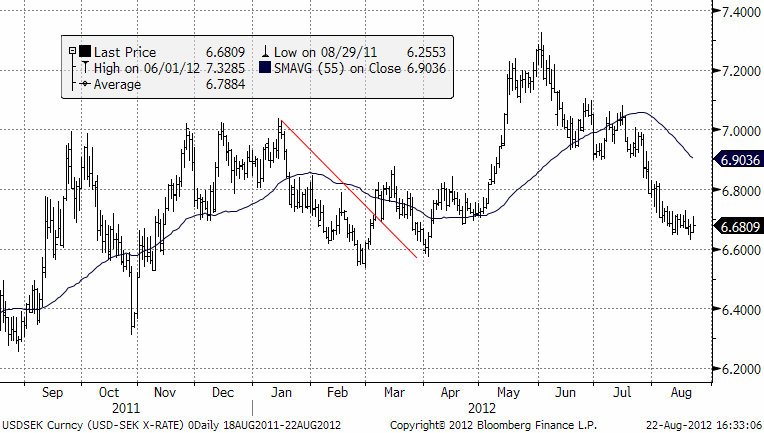Analys
SEB Jordbruksprodukter, 23 augusti 2012
 Priserna på jordbruksprodukter har fortsatt upp med potatis i spetsen. Tekniskt ser det ut som om priserna på spannmål och oljeväxter kommer att fortsätta stiga, men gårdagskvällens rapport från StatsCanada, som visar en av de största skördarna av spannmål någonsin och den största skörden av raps någonsin, fick marknaderna att tveka.
Priserna på jordbruksprodukter har fortsatt upp med potatis i spetsen. Tekniskt ser det ut som om priserna på spannmål och oljeväxter kommer att fortsätta stiga, men gårdagskvällens rapport från StatsCanada, som visar en av de största skördarna av spannmål någonsin och den största skörden av raps någonsin, fick marknaderna att tveka.
Pro Farmer crop tour visar en skörd i bättre skick än USDA har förutspått.
Eurozonen ser ut att gå mot en vecka där man får se sanningen i vitögat och det lär knappast öka konsumtionsviljan.
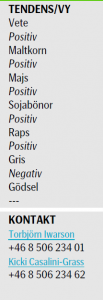 Vi tror att detta kan vara ett köptillfälle och vi fortsätter att tro på högre priser. Än har ransoneringen av konsumtionen av majs – den mest kritiska marknaden – och drivande för vetemarknaden – inte visat något tecken på att komma igång. Tvärtom, faktiskt. Såväl utfordring av djur i USA, som etanolproduktion i USA ökar enligt de senaste rapporterna.
Vi tror att detta kan vara ett köptillfälle och vi fortsätter att tro på högre priser. Än har ransoneringen av konsumtionen av majs – den mest kritiska marknaden – och drivande för vetemarknaden – inte visat något tecken på att komma igång. Tvärtom, faktiskt. Såväl utfordring av djur i USA, som etanolproduktion i USA ökar enligt de senaste rapporterna.
Odlingsväder
Southern Oscillation Index har fortsatt att sjunka och ligger nu på -12.5. Ett värde under -8 indikerar El Niño-förhållanden. Vi ser tecken på detta då nederbörden i östra Australien är torrare än normalt, medan den västra är fuktig. Vi ser att det har regnat rikligt över Argentina. Jordbruksmeteorologer vid Texas A&M Univerity i College Station har också diskonterat ett svalt och fuktigt Texas-klimat. Texas är svårt plågat av torka nu och får ses som indikator på vad som händer med marknaderna på kött nu. Från Vietnam, världens största producent av robusta kaffe, rapporterar dålig tillväxt på grund av för lite nederbörd (små bönor). Allt detta hänger ihop med ett El Niño. Vi kan dessutom förvänta oss att det blir torrt i de fattiga och konfliktfyllda delarna av västra Afrika – och blött i Europa. Än så länge ser det dock inte ut att bli en allvarlig släng av El Niño.
Vete
Tekniskt ser vetepriset ut att vara på väg att ”bryta uppåt”. Tekniskt talar det mesta för att priset ska fortsätta uppåt och i så fall indikerar den tekniska analysen en potential upp till 286 euro. Jag skulle helst vilja se en liten uppgång till, så att den övre delen av triangeln bröts, för att vara än mer säker.
Nedan ser vi Chicagovetet med leverans i december. Den tekniska bilden indikerar samma sak här.
Västra Australien är torrt och lokala estimat ligger strax över räkneexemplet i förra veckobrevet. Däremot släppte StatsCanada igår kväll (onsdag) statistik som visade att skörden kan bli rekordstor i Kanada. Total veteskörd på prärien väntas enligt rapporten uppgå till 24.8 mt, vilket är 9.7% mer än förra året. Korn-skörden väntas öka 23.8% till 9 mt pga en rekordhög hektarskörd på 65.1 bu/acre.
I diagrammet nedan ser vi terminspriserna framåt i tiden för Chicago och Matif och förändringen från 7 dagar sedan. Vi ser att backwardation har ökat på båda sidor av Atlanten. Priset för leverans nästa november (2013) är ca 20 euro per ton högre i Chicago än i Paris. Däremot är priset på Matif och Chicago ungefär desamma för leverans av årets skörd. Ska man prissäkra årets skörd ska man kanske tänka på att den högre korrelationen mellan prisförändringar på vårt vete och Matifs är mycket högre än med Chicagos. Ska man prissäkra nästa års skörd är det, som nästan alltid, bättre betalt när man säljer Chicago.
Ryssland blev igår onsdag officiellt en medlem i WTO, men vi har ju redan förklarat att detta på intet sätt hindrar dem att införa ett exportstopp, även om det kanske inte är opportunt att göra det kort tid efter att de skrivit på avtalet, som de väntat 19 år på. Indien har i veckan sagt att de inte ska införa exportbegränsningar på vete, bland annat.
Trots detta talas i världen allt mer om export + wheat + ban, som vi ser i diagrammet nedan. Det man talar om är hjärtat som bekant fullt av. Korrelationen mellan högre pris och exportbegränsningar är mycket hög. Den når nästan 0.8 vid maximum. Det finns all anledning att vara vaksam på rykten om och tecken på förestående exportbegränsningar.
Deutsche Bauernverbund (DBV) rapporterade i veckan att den tyska spannmålsskörden kan nå 43.8 mt, en ökning med 5% från förra året. Däremot kommer veteskörden sannolikt att minska med 6% till 21 mt, pga frostskador.
Maltkorn
Novemberkontraktet på maltkorn steg den här veckan, helt i linje med vad vi förutspådde förra veckan, i och för sig efter att först ha hunnit rekylera ännu lite mer. Novemberkontraktet är dock netto upp 1% sedan förra veckan.
Kanada är torrt i söder och blött i norr. Norra Europa och Storbritannien är som bekant blött, vilket leder till problem med skörden.
Potatis
Potatishaussen fortsatte den senaste veckan. Uppgången sedan förra veckans veckobrev är 14%. Bakgrunden är att den tidigast skördade potatisen i Beneluxländerna inte alls visade samma skörd man väntat sig. Se tabellen i slutet av veckobrevet för terminspriserna för nästa års skörd.
Majs
Majspriset har avslutat en teknisk så kallad ”flagga” och torde fortsätta uppåt. Den tekniska analysen visar att marknaden snart borde ta ut den tidigare toppen (vilket bekräftas om 931¾ bryts). Stödet på 774 höll vid den senaste nedgången, vilket stödjer oss i att nedgången var en rekyl och inte en mer övertygande nedgång. Köparna är alltså tillbaka i förarsätet och det borde bli en ny körare uppåt. Det gamla målet på 870 kan vara värt att komma ihåg.
Måndagens crop ratings för majs var totalt oförändrade för de 18 stater som detta rapporteras för. Pro Farmer Midwest Crop Tour pågår nu. Förra veckan fick den marknaden att acceptera en avkastning på mindre än 120 bu/acre. Igår (onsdag) kom rapport från Indiana, där man estimerar avkastningen till 113.3 bu/acre. Detta är faktiskt högre än de 100 bu/acre som USDA räknade med i den senaste WASDErapporten.
Indiana är den femte största sojaböns- och majsproducerande delstaten i USA. Torka påverkar nu 87% av amerikansk majsproduktion och 85% av sojaodlingen. Etanolproduktionen visar inga tecken på avta. Nedan ser vi ett diagram över daglig produktion i 1000 x fat per dag. Statistiken är veckovis och publiceras av US DOE på onsdagar. Vi ser alltså en ökning till 823,000 fat / dag den senaste veckan.
Däremot slaktas boskap. Från Texas A&M rapporteras att boskapen stödutfordras, men att det är svårt att få tag på foder. Därför går många djur till slakt.
Sojabönor
Triangelformationen är bruten på uppsidan vilket bekräftar den uppåtgående trenden. Vi kan sätta en teoretisk målkurs till 1879 cent / bu, så det finns enligt textboken gott om utrymme för en ordenlig hausse. Om marknaden faller tillbaka ner i triangeln bör man dock gå ur långa positioner.
Crop conditions visar en minskning på 1% i kategorin ”poor” och en ökning i ”good”. Pro Farmer Crop Tour i Indiana visade på ”pod count” på 1033 stycken (i en 3-fots kvadrat). Det är en minskning med 9.2% från förra året. USDA förutspådde i augusti-WASDE att avkastningen skulle minska med 18% till 37 bushels / acre. Att det regnat den senaste tiden, som medan det inte hjälpt majsen, kan möjligtvis göra att de färre baljorna får något större bönor, vilket också skulle höja skörden mer än ”pod count” visar.
Det regnar också ordentligt i Argentina och Brasilien går mot en rekordskörd. Marknaden kan möjligen ta fasta på dessa positiva nyheter de närmaste dagarna.
Raps
Rapsterminen är snart på en ny högstanotering i trenden uppåt. Sedan förra veckan har marknaden fortsatt att avancera. På kort sikt säger den tekniska analysen att de finns en risk före en rekyl ned mot 513 euro. Om det händer ska man se det som ett köptillfälle inför nya högre noteringar. Det har kommit två negativa nyheter, som kan ge något för marknaden något att ta fasta på för att handla ner priset till 513-nivån.
StatsCanada igår kväll (onsdag) statistik som visade att skörden av canola väntas bli rekordhöga 15.2 mt. Förra årets rekordnotering på 14 mt blir därmed slagen. Deutsche Bauernverbund (DBV) rapporterade i veckan att den tyska skörden av rapsfrö kommer att öka med 15% till 4.4 mt.
Gris
Genombrottet av stödet är nu bekräftat och priset kan fortsätta nedåt. Vi tror att nya kontraktslägsta väntar kring hörnet. Live Cattle föll igår till den lägsta noteringen på två veckor. Slakterier processade 259,000 djur de första två dagarna den här veckan. Det är 3.6% mer än förra veckan och 1.6% mer än för ett år sedan, enligt data från USDA. Det är de höga foderpriserna som ökar slakten och minskar hjordarna. Vi ska komma ihåg att priset på majs har stigit med 63% sedan den 15 juni. Juli månad är den varmaste någonsin i USA, sedan man började mäta.
Crop Condition rapporteras även för Pasture and Range Condition. För alla 48 stater är det endast 2% som är “Excellent” condition. 15% är ”good” och 60% är i poor eller very poor. Det är de hårda fakta som påverkar.
Att då tvingas köpa dyrt och nu alltså ännu dyrare majs, är naturligtvis inte kul. På lite sikt kommer detta naturligtvis att leda till en minskad efterfrågan på majs. Det är den ransonering som priset leder till, så att majsen inte tar slut. Men torkan leder alltså hittills paradoxalt till att efterfrågan på majs först ökar.
Nedan ser vi baissen på grismarknaden.
Mjölk
Priset på mjölkpulver i Nordeuropa har fortsatt att stiga ännu en vecka. Priset har ökat 4% från 2538 euro per ton till 2625.
Nedan ser vi priset på smör såsom handlat på EUREX. Priset är angivet i euro per ton.
Tar man 7 kontrakt skummjölkspulver och ett kontrakt smör, får man priset på mjölk. Så enkelt är det att få fram ett börspris på råvaran mjölk. Fördelen med börser är att de ger ”price discovery”. Det är en viktig roll för en råvarubörs. Den får marknadsekonomin att fungera bättre, när alla nästan gratis kan få tillgång till ”rätt” pris och planera sin produktion och konsumtion på basis av det. Råvarubörserna har en annan funktion också, och det är att göra det möjligt att försäkra sig, skydda sig mot risk på priset.
På den amerikanska börsen har priset också stigit. EUREX som representerar marknaden i Europa har börjat bli allt mer med världsmarknadens pris, representerat av terminerna i Chicago.
Socker
Priset på socker har, såsom vi har förutspått, fortsatt att sjunka. Vi skrev för en vecka sedan att 20 cent är en psykologiskt viktig nivå. Marknaden tvekade lite där, men bröt sedan stödet. Det gör att vi tror att priset kommer att fortsätta ner mot 19 cent i första hand.
Brasiliens sockerrörsområden har haft uppehåll i regnen, vilket gör att skörden kan gå framåt snabbare.
EURSEK
EURSEK svarar på ett starkt tekniskt stöd. Vi tror på sidledes rörelse den närmaste veckan. Den långsiktiga trenden är alltjämt nedåtriktad.
USDSEK
Dollarn ligger fortfarande i supportområdet. Vi tror på sidledes rörelse den kommande veckan. Den långsiktiga trenden är uppåtriktad.
[box]SEB Veckobrev Jordbruksprodukter är producerat av SEB Merchant Banking och publiceras i samarbete och med tillstånd på Råvarumarknaden.se[/box]
Disclaimer
The information in this document has been compiled by SEB Merchant Banking, a division within Skandinaviska Enskilda Banken AB (publ) (“SEB”).
Opinions contained in this report represent the bank’s present opinion only and are subject to change without notice. All information contained in this report has been compiled in good faith from sources believed to be reliable. However, no representation or warranty, expressed or implied, is made with respect to the completeness or accuracy of its contents and the information is not to be relied upon as authoritative. Anyone considering taking actions based upon the content of this document is urged to base his or her investment decisions upon such investigations as he or she deems necessary. This document is being provided as information only, and no specific actions are being solicited as a result of it; to the extent permitted by law, no liability whatsoever is accepted for any direct or consequential loss arising from use of this document or its contents.
Analys
Tightening fundamentals – bullish inventories from DOE

The latest weekly report from the US DOE showed a substantial drawdown across key petroleum categories, adding more upside potential to the fundamental picture.

Commercial crude inventories (excl. SPR) fell by 5.8 million barrels, bringing total inventories down to 415.1 million barrels. Now sitting 11% below the five-year seasonal norm and placed in the lowest 2015-2022 range (see picture below).
Product inventories also tightened further last week. Gasoline inventories declined by 2.1 million barrels, with reductions seen in both finished gasoline and blending components. Current gasoline levels are about 3% below the five-year average for this time of year.
Among products, the most notable move came in diesel, where inventories dropped by almost 4.1 million barrels, deepening the deficit to around 20% below seasonal norms – continuing to underscore the persistent supply tightness in diesel markets.
The only area of inventory growth was in propane/propylene, which posted a significant 5.1-million-barrel build and now stands 9% above the five-year average.
Total commercial petroleum inventories (crude plus refined products) declined by 4.2 million barrels on the week, reinforcing the overall tightening of US crude and products.


Analys
Bombs to ”ceasefire” in hours – Brent below $70

A classic case of “buy the rumor, sell the news” played out in oil markets, as Brent crude has dropped sharply – down nearly USD 10 per barrel since yesterday evening – following Iran’s retaliatory strike on a U.S. air base in Qatar. The immediate reaction was: “That was it?” The strike followed a carefully calibrated, non-escalatory playbook, avoiding direct threats to energy infrastructure or disruption of shipping through the Strait of Hormuz – thus calming worst-case fears.

After Monday morning’s sharp spike to USD 81.4 per barrel, triggered by the U.S. bombing of Iranian nuclear facilities, oil prices drifted sideways in anticipation of a potential Iranian response. That response came with advance warning and caused limited physical damage. Early this morning, both the U.S. President and Iranian state media announced a ceasefire, effectively placing a lid on the immediate conflict risk – at least for now.
As a result, Brent crude has now fallen by a total of USD 12 from Monday’s peak, currently trading around USD 69 per barrel.
Looking beyond geopolitics, the market will now shift its focus to the upcoming OPEC+ meeting in early July. Saudi Arabia’s decision to increase output earlier this year – despite falling prices – has drawn renewed attention considering recent developments. Some suggest this was a response to U.S. pressure to offset potential Iranian supply losses.
However, consensus is that the move was driven more by internal OPEC+ dynamics. After years of curbing production to support prices, Riyadh had grown frustrated with quota-busting by several members (notably Kazakhstan). With Saudi Arabia cutting up to 2 million barrels per day – roughly 2% of global supply – returns were diminishing, and the risk of losing market share was rising. The production increase is widely seen as an effort to reassert leadership and restore discipline within the group.
That said, the FT recently stated that, the Saudis remain wary of past missteps. In 2018, Riyadh ramped up output at Trump’s request ahead of Iran sanctions, only to see prices collapse when the U.S. granted broad waivers – triggering oversupply. Officials have reportedly made it clear they don’t intend to repeat that mistake.
The recent visit by President Trump to Saudi Arabia, which included agreements on AI, defense, and nuclear cooperation, suggests a broader strategic alignment. This has fueled speculation about a quiet “pump-for-politics” deal behind recent production moves.
Looking ahead, oil prices have now retraced the entire rally sparked by the June 13 Israel–Iran escalation. This retreat provides more political and policy space for both the U.S. and Saudi Arabia. Specifically, it makes it easier for Riyadh to scale back its three recent production hikes of 411,000 barrels each, potentially returning to more moderate increases of 137,000 barrels for August and September.
In short: with no major loss of Iranian supply to the market, OPEC+ – led by Saudi Arabia – no longer needs to compensate for a disruption that hasn’t materialized, especially not to please the U.S. at the cost of its own market strategy. As the Saudis themselves have signaled, they are unlikely to repeat previous mistakes.
Conclusion: With Brent now in the high USD 60s, buying oil looks fundamentally justified. The geopolitical premium has deflated, but tensions between Israel and Iran remain unresolved – and the risk of missteps and renewed escalation still lingers. In fact, even this morning, reports have emerged of renewed missile fire despite the declared “truce.” The path forward may be calmer – but it is far from stable.
Analys
A muted price reaction. Market looks relaxed, but it is still on edge waiting for what Iran will do

Brent crossed the 80-line this morning but quickly fell back assigning limited probability for Iran choosing to close the Strait of Hormuz. Brent traded in a range of USD 70.56 – 79.04/b last week as the market fluctuated between ”Iran wants a deal” and ”US is about to attack Iran”. At the end of the week though, Donald Trump managed to convince markets (and probably also Iran) that he would make a decision within two weeks. I.e. no imminent attack. Previously when when he has talked about ”making a decision within two weeks” he has often ended up doing nothing in the end. The oil market relaxed as a result and the week ended at USD 77.01/b which is just USD 6/b above the year to date average of USD 71/b.

Brent jumped to USD 81.4/b this morning, the highest since mid-January, but then quickly fell back to a current price of USD 78.2/b which is only up 1.5% versus the close on Friday. As such the market is pricing a fairly low probability that Iran will actually close the Strait of Hormuz. Probably because it will hurt Iranian oil exports as well as the global oil market.
It was however all smoke and mirrors. Deception. The US attacked Iran on Saturday. The attack involved 125 warplanes, submarines and surface warships and 14 bunker buster bombs were dropped on Iranian nuclear sites including Fordow, Natanz and Isfahan. In response the Iranian Parliament voted in support of closing the Strait of Hormuz where some 17 mb of crude and products is transported to the global market every day plus significant volumes of LNG. This is however merely an advise to the Supreme leader Ayatollah Ali Khamenei and the Supreme National Security Council which sits with the final and actual decision.
No supply of oil is lost yet. It is about the risk of Iran closing the Strait of Hormuz or not. So far not a single drop of oil supply has been lost to the global market. The price at the moment is all about the assessed risk of loss of supply. Will Iran choose to choke of the Strait of Hormuz or not? That is the big question. It would be painful for US consumers, for Donald Trump’s voter base, for the global economy but also for Iran and its population which relies on oil exports and income from selling oil out of that Strait as well. As such it is not a no-brainer choice for Iran to close the Strait for oil exports. And looking at the il price this morning it is clear that the oil market doesn’t assign a very high probability of it happening. It is however probably well within the capability of Iran to close the Strait off with rockets, mines, air-drones and possibly sea-drones. Just look at how Ukraine has been able to control and damage the Russian Black Sea fleet.
What to do about the highly enriched uranium which has gone missing? While the US and Israel can celebrate their destruction of Iranian nuclear facilities they are also scratching their heads over what to do with the lost Iranian nuclear material. Iran had 408 kg of highly enriched uranium (IAEA). Almost weapons grade. Enough for some 10 nuclear warheads. It seems to have been transported out of Fordow before the attack this weekend.
The market is still on edge. USD 80-something/b seems sensible while we wait. The oil market reaction to this weekend’s events is very muted so far. The market is still on edge awaiting what Iran will do. Because Iran will do something. But what and when? An oil price of 80-something seems like a sensible level until something do happen.
-

 Nyheter3 veckor sedan
Nyheter3 veckor sedanStor uppsida i Lappland Guldprospekterings aktie enligt analys
-

 Nyheter4 veckor sedan
Nyheter4 veckor sedanBrookfield ska bygga ett AI-datacenter på hela 750 MW i Strängnäs
-

 Nyheter3 veckor sedan
Nyheter3 veckor sedanSilverpriset släpar efter guldets utveckling, har mer uppsida
-

 Nyheter3 veckor sedan
Nyheter3 veckor sedanUppgången i oljepriset planade ut under helgen
-

 Nyheter3 veckor sedan
Nyheter3 veckor sedanLåga elpriser i sommar – men mellersta Sverige får en ökning
-

 Analys3 veckor sedan
Analys3 veckor sedanVery relaxed at USD 75/b. Risk barometer will likely fluctuate to higher levels with Brent into the 80ies or higher coming 2-3 weeks
-

 Nyheter2 veckor sedan
Nyheter2 veckor sedanMahvie Minerals växlar spår – satsar fullt ut på guld
-

 Nyheter1 vecka sedan
Nyheter1 vecka sedanOljan, guldet och marknadens oroande tystnad


